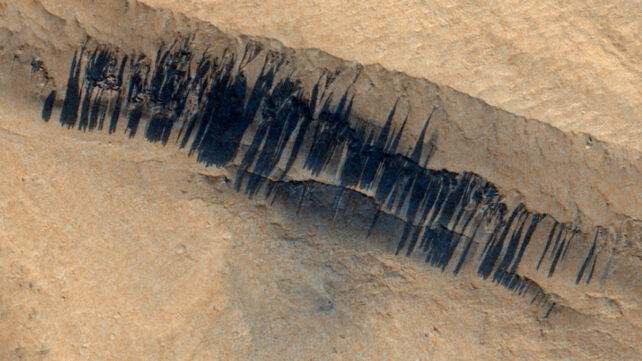Streaks that form on the slopes of Mars, also known as recurring slope lineae (RSL), are a common feature on Mars. These dark, seasonal streaks are either the result of briny water patching thawing from seasonal ices or dry sand being displaced.
While the exact cause remains unknown, new research continues to reveal clues about this picturesque phenomenon. Case in point, the ESA's ExoMars Trace Gas Orbiter (TGO) recently captured images of streaks formed from a dust avalanche on the slopes of Apollinaris Mons the night before Christmas in 2023.
The image was acquired by the TGO's Colour and Stereo Surface Imaging System (CaSSIS), and shows a faint clustering of impact craters and the dark streaks at the bottom of the slope.
These streaks were the subject of a paper, "Dust, sand and wind drive slope streaks on Mars," recently published in the journal Nature Communications.
Related: Life on Mars? NASA's Stunning Discovery Is The Best Evidence Yet
As indicated by author Valentin Tertius Bickel, a postdoctoral researcher from the Center for Space and Habitability (CSH) at the University of Bern, recent geostatistical evidence has shown that RSL can be caused by "dry," non-seasonal factors.
However, he argues, direct, quantitative measurements of the rate of dark streak formation and the frequency with which they occur due to specific factors are currently lacking.
To this end, he considered the streak captured by the TGO, which scientists have determined was caused by meteorite impacts that happened between 2013 and 2017.
Valentine relied on machine learning to analyze more than two million streaks captured by NASA's Mars Reconnaissance Orbiter (MRO) between 2006 and 2024, and which were likely associated with dry nonseasonal drivers, including meteoroid impacts, marsquakes, and winds.
From this, he was able to develop a "streak census" that showed the majority of these features occurred in five distinct hotspots over the nineteen years in question. He further determined that about 0.1% of the annually formed population could be directly attributed to events such as meteoroid impacts and marsquakes.

"Dust, wind, and sand dynamics appear to be the main seasonal drivers of slope streak formation," Bickel said in an ESA press release.
"Meteoroid impacts and quakes seem to be locally distinct, yet globally relatively insignificant drivers."
These results provide vital evidence that could settle the debate on what causes dark streaks to form on Mars. They also offer insight into the kinds of dynamic forces that shape the Martian climate, both seasonally and non-seasonally.
"These observations could lead to a better understanding of what happens on Mars today," says Colin Wilson, ESA's project scientist for the ExoMars Trace Gas Orbiter. "Obtaining long-term, continuous, and global-scale observations that reveal a dynamic Mars is a key objective of present and future orbiters."
In particular, understanding the dynamics of the planet's environment could answer the most fundamental questions scientists have about Mars.
These include how and when its surface water disappeared, where it went, and whether or not life could have flourished there at one time.
Addressing these questions is the primary objective of the nine missions operated by five space agencies that are currently exploring Mars. More robotic missions are planned, with crewed missions planned before mid-century.
This article was originally published by Universe Today. Read the original article.

